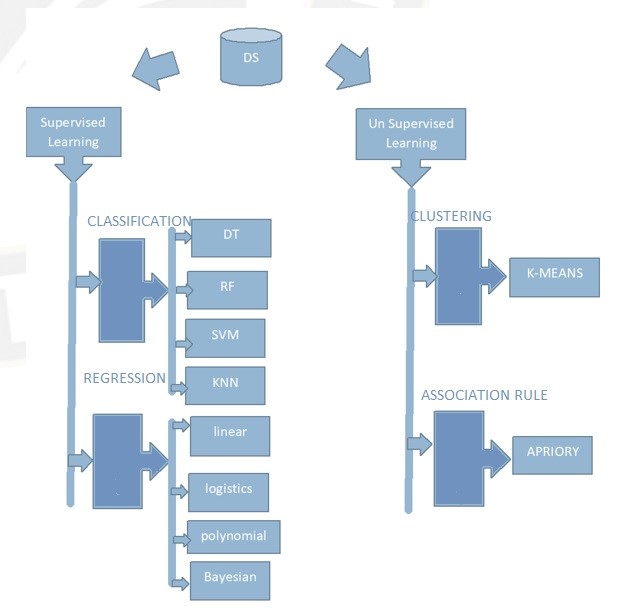Randomized Ensemble Approach with ID3 Algorithm For the Prediction datasets with Imbalance Problem
Main Article Content
Abstract
Nowadays, it is significant to make accurate prediction model by handling imbalance problem. When the larger dataset has been used in the prediction model, that data should be classified into classes which gives ‘0’ and ‘1’ to indicate negative and positive results. While classifying this target value, the larger number of instances can reside in one class and the remaining lower number of instances can be stored in another class. Because of this unequal distribution of data, the machine can be biased and there is high possibility to give wrong predictions. An inaccurate Dataset leads to misprediction. Hence, the imbalanced prediction dataset has been taken. This paper gives a proper information on Randomized ensemble approach with ID3 classifier for the imbalanced prediction dataset.
Article Details
References
G Li Y-F, Guo L-Z, Zhou Z-H (2021) Towards safe weakly supervised learning. IEEE Trans Pattern Anal Mach Intell 43(1):334–346
Sasirekha, R., Kanisha, B., Kaliraj, S. (2022). Study on Class Imbalance Problem with Modified KNN for Classification. In: Hemanth, D.J., Pelusi, D., Vuppalapati, C. (eds) Intelligent Data Communication Technologies and Internet of Things. Lecture Notes on Data Engineering and Communications Technologies, vol 101. Springer, Singapore. https://doi.org/10.1007/978-981-16-7610-9_15.
S. R and K. B, "KNN Based Peak-LOF for Outlier Detection," 2022 International Conference on Innovative Computing, Intelligent Communication and Smart Electrical Systems (ICSES), Chennai, India, 2022, pp. 1-5, doi: 10.1109/ICSES55317.2022.9914212.
Abraham B, Nair MS. Computer-aided detection of COVID-19 from X-ray images using multi-CNN and Bayesnet classifier. Biocybern Biomed Eng. 2020;40(4):1436-1445. doi:10.1016/j.bbe.2020.08.005.
Ihya, Rachida & Namir, Abdelwahed & Filali, Sanaa & Aitdaoud, Mohammed & Guerss, Fatima zahra. (2019). J48 algorithms of machine learning for predicting user's the acceptance of an E-orientation systems. SCA '19: Proceedings of the 4th International Conference on Smart City Applications. 1-8Y. Yorozu, M. Hirano, K. Oka, and Y. Tagawa, “Electron spectroscopy studies on magneto-optical media and plastic substrate interface,” IEEE Transl. J. Magn. Japan, vol. 2, pp. 740–741, August 1987 [Digests 9th Annual Conf. Magnetics Japan, p. 301, 1982].
B. Cao, Y. Liu, C. Hou, J. Fan, B. Zheng and J. Yin,"Expediting the Accuracy-Improving Process of SVMs for Class Imbalance Learning," in IEEE Transactions on Knowledge and Data Engineering, vol. 33, no. 11, pp. 3550-3567, 1 Nov. 2021, doi: 10.1109/TKDE.2020.2974949
B. A. Al-Hameli, A. A. Alsewari, M. Khubrani and M. Fakhreldin, "Accuracy and performance analysis for classification algorithms based on biomedical datasets," 2021 International Conference on Software Engineering & Computer Systems and 4th International Conference on Computational Science and Information Management (ICSECS-ICOCSIM), Pekan, Malaysia, 2021, pp. 620-624, doi: 10.1109/ICSECS52883.2021.00119.
R. Gomes da Silva, J. de Oliveira Liberato Magalhães, I. R. Rodrigues Silva, R. Fagundes, E. Lima and A. Maciel, "Rating Prediction of Google Play Store apps with application of data mining techniques," in IEEE Latin America Transactions, vol. 19, no. 01, pp. 26-32, January 2021, doi: 10.1109/TLA.2021.9423823.
H. Goto, Y. Hasegawa, and M. Tanaka, “Efficient Scheduling Focusing on the Duality of MPL Representatives,” Proc. IEEE Symp. Computational Intelligence in Scheduling (SCIS 07), IEEE Press, Dec. 2007, pp. 57-64, doi:10.1109/SCIS.2007.357670.
V. K. Gupta, A. Gupta, D. Kumar and A. Sardana, "Prediction of COVID-19 confirmed, death, and cured cases in India using random forest model," in Big Data Mining and Analytics, vol. 4, no. 2, pp. 116-123, June 2021, doi: 10.26599/BDMA.2020.9020016.

